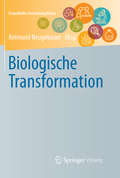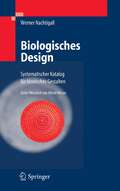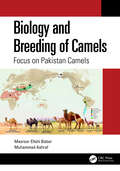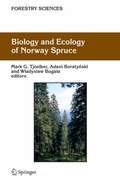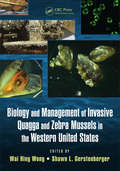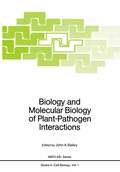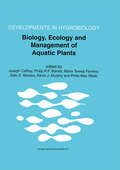- Table View
- List View
Biologische Transformation
by Reimund NeugebauerFür das Jahr 2050 erwarten wir eine Erdbevölkerung von 9,8 Milliarden Menschen – die letztlich alle nach Wohlstand streben. Auf der Suche nach einer effizienteren Produktion müssen daher neue Wege gefunden werden. Die bisherige Forschung zeigt, dass das evolutionär entstandene Inventar der Biologie, seine Produkte, Verfahren, Prinzipien und Werkzeuge, die Technik von heute enorm beflügeln kann. Die biologisch orientierte Konzeption technischer Entwicklungen mit dem Ziel einer besonders innovativen und nachhaltigen Wertschöpfung wird heute als „Biologische Transformation“ zusammengefasst. Sie führt zu hochfunktionellen Produkten mit bestechenden Eigenschaften, die zugleich ressourcenschonend hergestellt und benutzt werden können.Im Sinne der Verantwortung für das Wohl aller Menschen ist die Biologische Transformation daher ein Weg, den die angewandte Forschung gehen muss. Die Fraunhofer-Gesellschaft hat das entwicklungstechnische Potenzial der Biologischen Transformation erkannt und sieht ihre Aufgabe darin, nicht nur die einschlägige Forschung voranzutreiben, sondern auch die Wahrnehmung des Themas in der Bevölkerung zu fördern.
Biologische Wirkung von Licht im Kraftfahrzeug: Potenzialbewertung und Gestaltungsempfehlung für Lichtanwendungen zur Unterstützung von Passagieren im automobilen Innenraum (AutoUni – Schriftenreihe #163)
by Michael WengDas vorliegende Buch liefert einen empirischen Beitrag dazu, das Potenzial für den Einsatz biologisch wirksamer Lichtapplikationen im Innenraum von Kraftfahrzeugen besser beurteilen zu können und gibt Hinweise für die Gestaltung entsprechender Anwendungen. Die Ergebnisse aus drei Probandenstudien zeigen große individuelle Unterschiede in der Wirksamkeit solcher Lichtexpositionen auf die Physiologie von Menschen auf, bekräftigen aber zumindest für einen Teil der Probanden eine biologische Einflussnahme und Steigerung der Wachsamkeit. Dabei sollten automobile Lichtapplikationen möglichst großflächig dargeboten werden, um einen ausreichenden visuellen Komfort zu gewährleisten.
Biologische Zerstörung der makromolekularen Werkstoffe (Chemie, Physik und Technologie der Kunststoffe in Einzeldarstellungen #15)
by Hans H. HaldenwangerIn den letzten 25 Jahren kamen in zunehmendem Maße neue synthetische Werkstoffe für zahlreiche Verwendungszwecke in Gebrauch, über deren V erhalten gegenüber pflanzlichen und tierischen Schädlingen erst Erfah rungen gesammelt werden mußten, ehe es möglich war, Prüfmethoden und Schutzmaßnahmen zur Verhinderung der biologischen Zerstörung dieser Materialien zu entwickeln. Seither sind über diese Themen zahlreiche V er öffentlichungen erschienen, und das Wissen auf diesem zwischen der Bio logie, der organischen Chemie, der Toxikologie und der Werkstoffkunde stehenden Gebiet hat eine gewisse Abrundung erfahren. Es erscheint deshalb nützlich, diesen Wissenstoff, der in den Buch- und Zeitschriftenveröffent lichungen der genannten Disziplinen und deren Teilgebieten erschienen ist, geschlossen darzustellen, was naturgemäß nicht ohne ein kurzes Eingehen auf das V erhalten, die Prüfung und die Konservierung der natürlichen organischen Werkstoffe möglich war. Es wurde als wichtig angesehen, dem Chemiker und Anwendungs techniker einen Überblick über die als Schädlinge in Betracht kommenden Organismen zu geben; doch ist es nicht der Sinn dieser Schrift, die Aufgabe der biologischen Bestimmungsbücher zu übernehmen. Für den Biologen werden die Angaben über Prüfmethoden und die Kultivierung der Prüf organismen von Wert sein. Die im Anhang wiedergegebenen Rezepte der Nährmedien dürften dem Fachmann gestatten, Prüfungen von Werkstoffen mit pflanzlichen und tierischen Schädlingen auszuführen, ohne dabei auf die Originalliteratur zurückgreifen zu müssen. Sollte die vorliegende Schrift darüber hinaus die Chemiker und Anwendungstechniker auf dem Kunst stoffgebiet zur Beschäftigung mit der biologischen Zerstörung der makro molekularen Werkstoffe anregen, so hat sie ihren Zweck erfüllt. Vinnhorst, den 1.
Biologisches Design: Systematischer Katalog für bionisches Gestalten
by Werner NachtigallMit diesem Nachschlagewerk wird eine systematische Katalogisierung der Lösungen angeboten, die dem Designer oder Konstrukteur einen großen Fundus zur kreativen Umsetzung in der Technik liefert.
Biology and Aquaculture of Tilapia
by José Fernando López-OlmedaThis book reviews up-to-date knowledge on the biology and aquaculture of tilapia, with special focus on the Nile tilapia (Oreochromis niloticus). Tilapia are a group of fish species that have become one of the most cultured worldwide, currently having a big economic impact on both developed and developing countries. The first 12 chapters of the present book cover different aspects of tilapia biology such as genetics, nutrition, osmoregulation, pathology, reproduction and development. Each chapter includes both basic knowledge and its application to tilapia culture. The last 3 chapters are devoted to cutting-edge techniques for the industry of tilapia aquaculture. Experts from both academia and research institutes provide their expertise on the present book.
Biology and Aquaculture of Tilapia
by José Fernando López-Olmeda Francisco Javier Sánchez-Vázquez Rodrigo Fortes-SilvaThis book reviews up-to-date knowledge on the biology and aquaculture of tilapia, with special focus on the Nile tilapia (Oreochromis niloticus). Tilapia are a group of fish species that have become one of the most cultured worldwide, currently having a big economic impact on both developed and developing countries. The first 12 chapters of the present book cover different aspects of tilapia biology such as genetics, nutrition, osmoregulation, pathology, reproduction and development. Each chapter includes both basic knowledge and its application to tilapia culture. The last 3 chapters are devoted to cutting-edge techniques for the industry of tilapia aquaculture. Experts from both academia and research institutes provide their expertise on the present book.
Biology and Biotechnology of Patagonian Microorganisms
by Nelda Lila Olivera Diego Libkind Edgardo DonatiThe Argentinean Patagonia offers a great diversity of scarcely explored environments suitable for the bioprospection of biotechnological relevant microorganisms. This book provides readers with a concise and clearly illustrated treatment of outstanding topics of Patagonian microbiology and biotechnology. It covers a wide range of areas interesting to several audiences such as researchers, graduate students and professionals working on the industry food. Among the main topics we will discuss examples of environmental applications, such as heavy metal and hydrocarbon bioremediation, bioprospection of valuable molecules from extremophilic bacteria and yeasts, the use of Patagonian yeasts and lactic acid bacteria in fermented foods and beverages, aquaculture probiotics and yeasts for food biopreservation.
Biology and Biotechnology of Quinoa: Super Grain for Food Security
by Ajit VarmaThis book is designed to popularize Quinoa cereal among both scientific and food industry. Quinoa is an attractive candidate for protein replacement, has potential for futuristic biotechnological modifications, and is able to grow under many different abiotic stresses. To save the world from animal cruelty, quinoa emerges as a hero for vegans and vegetarians. This book deals with morphological features, life cycle, nutritional qualities, genetics, agronomic manipulations, ecological communications, stress tolerance mechanisms, and food applications of Chenopodium quinoa. Quinoa is a pseudo-cereal native to Andes Region in South America. Over time, it spread to many different regions worldwide and is emerging as protein-rich vegetarian food source. In order to cure malnutrition globally, it is important to channel this lesser-known grain to local cultivators. This can only be done through well-proven scientific data that supports its qualities. This book aims to do the same, while also giving an insight into the vast scope quinoa posses as an experimental crop. Its stress-tolerant abilities can inspire scientists to understand those mechanisms, further exploit them, and even introduce them into other stress-sensitive crops. In future, quinoa can be among the top sources that offer food security. Due to its adaptability, ease of cultivation, and rich output, sustainability can be achieved by regulating its breeding and growth. This book is of interest to researchers, teachers, agronomic cultivators, environmentalists, botanists, microbiologists, geneticists and food technologists. This book covers recent advances, challenges in cultivation, biology, nutrition, and agricultural science topics, suitable for both young learners and advanced scientists. Cultivators who want to know more about quinoa and introduce it into their agronomic applications will find helpful information from the text.
Biology and Breeding of Camels: Focus on Pakistan Camels
by Masroor Ellahi Babar Muhammad AshrafThis book discusses the biology, breeding, care, and management of camels, with a focus on camels from Pakistan. The book provides a sound understanding of how to look after camels, their senses, behavior, and adaptations. The chapters describe the practical aspects of camel husbandry such as how to maintain their body condition, feet, and cleanliness. It covers the types of feeds, feeding methods, and their needs at different stages of life. The book provides a detailed account of camel husbandry, breeding, and reproduction. It is meant for camel breeders, veterinarians, livestock advisers, students, and researchers working on animal sciences, camel rearing, feeding, and management.FEATURES Includes information about different species of camels present in Pakistan and their importance to humans Discusses the nutrition and feeding of camels, the medicinal qualities of camel milk, and the peculiar immunity-enhancing properties of their nutritious meat Describes the features of camels that help them survive and thrive in deserts and make them the animals of the future Covers the range of unique products obtained from camels and their economic value Explores the management, types of diseases in camels, causes of their spread, their control, and therapeutic measures for successful and productive farming
Biology and Breeding of Camels: Focus on Pakistan Camels
by Masroor Ellahi Babar Muhammad AshrafThis book discusses the biology, breeding, care, and management of camels, with a focus on camels from Pakistan. The book provides a sound understanding of how to look after camels, their senses, behavior, and adaptations. The chapters describe the practical aspects of camel husbandry such as how to maintain their body condition, feet, and cleanliness. It covers the types of feeds, feeding methods, and their needs at different stages of life. The book provides a detailed account of camel husbandry, breeding, and reproduction. It is meant for camel breeders, veterinarians, livestock advisers, students, and researchers working on animal sciences, camel rearing, feeding, and management.FEATURES Includes information about different species of camels present in Pakistan and their importance to humans Discusses the nutrition and feeding of camels, the medicinal qualities of camel milk, and the peculiar immunity-enhancing properties of their nutritious meat Describes the features of camels that help them survive and thrive in deserts and make them the animals of the future Covers the range of unique products obtained from camels and their economic value Explores the management, types of diseases in camels, causes of their spread, their control, and therapeutic measures for successful and productive farming
Biology and Breeding of Crucifers
by Surinder Kumar GuptaConsiderable interest has developed in recent years in crucifers and particularly in their wild relatives, as they contain genetic material that may be utilized for further evolution of superior crop varieties through introgression and distant hybridization. Until now, there has been no single volume that focuses exclusively on the biology and bree
Biology and Chemistry of Jerusalem Artichoke: Helianthus tuberosus L.
by Stanley J. Kays Stephen F. NottinghamA unique plant on many levels, the distinctive properties of the Jerusalem artichoke, or Helianthus tuberosus L., present novel answers to some of today's most pressing problems. The potential of Jerusalem artichoke as a source for inulin, a fructose polymer that may provide dietary health benefits for obesity, diabetes, and several other health is
Biology and Control Theory: Current Challenges (Lecture Notes in Control and Information Sciences #357)
by Isabelle Queinnec Sophie Tarbouriech Germain Garcia Silviu-Iulian NiculescuCreating some links between control feedback and biology modeling communities based on similarities in modeling, observing and perceiving alive structures, and analyzing interconnections between biological structures and subsystems was the main objective of this volume. In this context, biology systems need appropriate analysis tools due to their structure and hierarchy, complexity and environment interference, and we believe that these aspects may generate interesting research topics in control area. Indeed, several works, raising the potential impact of control developments to bring some beginning of answers in the context of biological systems, have been published in the recent years. The idea of this book was conceived in the context mentioned above with the objective to help in claiming many of the problems for control researchers, starting discussions and opening interactive debates between the control and biology communities, and, finally, to alert graduate students to the many interesting ideas at the frontier between control feedback theory and biology.
Biology and Ecology of Earthworms
by Clive A. Edwards Norman Q. AranconBiology and Ecology of Earthworms is established as a key valuable text for students of agriculture, soil science, and soil invertebrate zoology and ecology. This is the 4th Edition of the popular textbook which reviews all aspects of earthworm biology and ecology. The book has been fully revised and updated throughout. Particular changes include: new treatments of earthworm taxonomy, diversity, migration and geographical distribution; interactions between earthworms and other soil organisms, especially microorganisms and soil-borne pests and diseases; as well as the importance of earthworms in organic waste management.
Biology and Ecology of Fishes
by James S. Diana Tomas O. HöökBiology and Ecology of Fishes Immerse yourself in the world of fish ecology with the newest edition of this essential introduction The study of fish ecology has traditionally proceeded along two tracks: the first is more basic, concerned with the anatomy, physiology and theoretical ecology of fish, and the second is more practical, concerning itself with fish populations, management, and habitats. Many fish researchers have come to view this distinction as artificial, and to develop a new study of fish that combines both tracks in a single holistic approach. It has never been more critical for introductory textbooks to represent this combined study in order to prepare the next generation of fish biologists and fishery scientists. Biology and Ecology of Fishes meets this need with a textbook that incorporates both biology and population management. Beginning with a general introduction to aquatic life and ecosystems, this book covers anatomical, environmental, and ethological topics to give a thoroughly rounded view of its subject, promising to serve as the fundamental introduction to multidisciplinary fish studies. Readers of the third edition of Biology and Ecology of Fishes will also find: Detailed coverage of subjects including growth and bioenergetics, feeding and predation, mortality and recruitment and more Increased attention to stressors of fish populations and communities New and revised chapters that introduce quantitative methods and present emerging issues facing fish populations and communities Biology and Ecology of Fishes is a useful overview for advanced undergraduate and graduate students studying fish ecology or fishery biology, as well as a reference for researchers and professionals in fish ecology, fish population management, and related fields.
Biology and Ecology of Fishes
by James S. Diana Tomas O. HöökBiology and Ecology of Fishes Immerse yourself in the world of fish ecology with the newest edition of this essential introduction The study of fish ecology has traditionally proceeded along two tracks: the first is more basic, concerned with the anatomy, physiology and theoretical ecology of fish, and the second is more practical, concerning itself with fish populations, management, and habitats. Many fish researchers have come to view this distinction as artificial, and to develop a new study of fish that combines both tracks in a single holistic approach. It has never been more critical for introductory textbooks to represent this combined study in order to prepare the next generation of fish biologists and fishery scientists. Biology and Ecology of Fishes meets this need with a textbook that incorporates both biology and population management. Beginning with a general introduction to aquatic life and ecosystems, this book covers anatomical, environmental, and ethological topics to give a thoroughly rounded view of its subject, promising to serve as the fundamental introduction to multidisciplinary fish studies. Readers of the third edition of Biology and Ecology of Fishes will also find: Detailed coverage of subjects including growth and bioenergetics, feeding and predation, mortality and recruitment and more Increased attention to stressors of fish populations and communities New and revised chapters that introduce quantitative methods and present emerging issues facing fish populations and communities Biology and Ecology of Fishes is a useful overview for advanced undergraduate and graduate students studying fish ecology or fishery biology, as well as a reference for researchers and professionals in fish ecology, fish population management, and related fields.
Biology and Ecology of Norway Spruce (Forestry Sciences #78)
by Mark G. Tjoelker Adam Boratynski Wladyslaw BugalaThis is a concise and comprehensive review of the biology, ecology, and management of Norway spruce. Written by 25 experts in the field, and richly illustrated, it integrates classic and contemporary literature. More than 2000 works are cited in the text, which highlights basic research and forestry practices in central and Eastern Europe. The huge range of topics covered includes the species’ morphology, its physiology and nutrition, and its ecology.
Biology and Management of Invasive Quagga and Zebra Mussels in the Western United States
by Wai Hing Wong Shawn L. GerstenbergerBiology and Management of Invasive Quagga and Zebra Mussels in the Western United States is a synthesis of the biology and management of invasive mussels from scientists and managers working on invasive quagga and zebra mussels in the western United States. Invasive dreissenid mussels have spread throughout southwestern United States at unprecedent
Biology and Management of the Formosan Subterranean Termite and Related Species
by Thomas Chouvenc J. Kenneth Grace Claudia Husseneder Shuji Itakura Hou-Feng Li Nathan Lo Kok-Boon Neoh Wakako Ohmura Faith M. Oi Rudolf H. Scheffrahn Qian Sun Gaku Tokuda Edward L. Vargo Chia-Chien Wu Koichi YamamotoThe Formosan subterranean termite, Coptotermes formosanus, is the most destructive and invasive termite species globally. It is also the only termite species listed in the world's 100 worst invasive alien species of the Global Invasive Species Database. Annually, its infestation costs more than $4 billion in control and damage repairs in the USA alone. This book is the first comprehensive resource drawing on all the literature on C. formosanus since Tokuichi Shiraki first described the species in 1909. The book covers the worldwide distribution of this species, its biogeography, and how it has dispersed from its native range in southern China and Taiwan to different parts of the world. It describes its present taxonomic status and discusses the species' biology, ecology, foraging behavior, physiology, chemical ecology and its association with symbionts. From a practical standpoint, the authors address all of the various management options for this species, such as baits, soil termiticides, wood preservatives, inspection and detection technologies, and Integrated Pest Management (IPM) approaches. Lastly, there are chapters dedicated to another important destructive species, Coptotermes gestroi (the Asian subterranean termite), and the recently discovered C. formosanus/C. gestroi hybrids. This important book is an essential and valuable reference for researchers, graduate students, pest management professionals, chemical manufacturer personnel, building and property managers, and others. It provides readers with a comprehensive understanding of the biology and management of the Formosan subterranean termite and the Asian subterranean termite.
Biology and Mechanics of Blood Flows: Part I: Biology (CRM Series in Mathematical Physics)
by Marc ThirietThis authoritative work presents the basic knowledge and state-of-the-art techniques necessary to carry out investigations of the cardiovascular system using modeling and simulation. The book provides a survey of relevant cell components and processes, with detailed coverage of the electrical and mechanical behaviors of vascular cells, tissues, and organs. Biological and mechanical glossaries are provided.
Biology and Mechanics of Blood Flows: Part II: Mechanics and Medical Aspects (CRM Series in Mathematical Physics)
by Marc ThirietThis authoritative book presents the basic knowledge and state-of-the-art techniques necessary to carry out investigations of the cardiovascular system using modeling and simulation. This volume contains chapters on anatomy, physiology, continuum mechanics, as well as pathological changes in the vasculature walls including the heart and their treatments. Methods of numerical simulations are given and illustrated in particular by application to wall diseases.
Biology and Molecular Biology of Plant-Pathogen Interactions (Nato ASI Subseries H: #1)
by John A. BaileyThis book is a collection of papers presented at a NATO Advanced Research Workshop on "Biology and Molecular Biology of Plant-Pathogen Interactions" which was held at Dillington College, Ilminster, UK, 1-6 September 1985. It had been preceded by Advanced Study Institutes at Porte Conte, Sardinia in 1975 and at Cape Sounion, Greece in 1981. In recent years, methods for the manipulation and transfer of genes have revolutionized our understanding of gene structure and function. It was thus opportune to bring together scientists from distinct disciplines, e. g. plant pathology, cytology, biochemistry and molecular biology to discuss our present understanding of cellular interactions between plants. We also explored how the potential offered by the newer molecular technologies could best be realized. It soon became evident at the Workshop, and is a repeated theme of this publication, that future research will need concentrated multi disciplinary programmes. Many of the new approaches will be valuable. For example, immunocytochemistry does, for the first time, allow molecules to be located precisely within infected tissues. Equally, the methods of DNA isolation and gene transformation will facilitate the isolation and characterization of genes associated with pathogenesis and specificity. The description at the Workshop of immunocytochemical protocols and of transformation systems for pathogenic fungi have already stimulated an upsurge in research on plant-pathogen relationships. The papers discuss many interactions between plants and fungal and bacterial pathogens, but also provide a comparison with mycorrhizal and symbiotic relationships, and those involving mycoparasites.
Biology, Biomimetics and Natural Design: Innovative Technologies and Sustainable Materials (Environmental Footprints and Eco-design of Products and Processes)
by Felipe Luis Palombini Amilton José Vieira de ArrudaFor billions of years, nature has provided efficient solutions to complex problems, by means of natural selection, in a harsh environment that only the fittest organisms survived. Such sustainable – still ruthless – driven evolution can be explored by designers, architects, engineers and more for the development of innovative projects. Biomimetics makes the link between Biology and Design, where features like shapes, mechanisms, colors, structures, and more can be analyzed, organized, modeled, and simulated for application in multiple creations. Therefore, such knowledge can contribute to more efficient and innovative solutions to many fields of applied science. This project aims to highlight some of the recent technological breakthroughs in Biology, Biomimetics and Natural Design that contribute to the development of sustainable and innovative materials and projects. This work consists of contributions from some of the main international groups of Biomimetics, exhibiting exciting cases of how technological advancements are leading to improved design solutions as well as shaping our very comprehension of nature and its complex organization.
Biology, Cultivation and Applications of Mushrooms
by Arun Arya Katerina RusevskaThe edited book consolidates information for profitable commercial cultivation of medicinal mushrooms. The book suggests a large number of substrates to the growers for use in commercial cultivation of Mushrooms. It also elucidates the conservation of wild endangered medicinal mushrooms. Mushrooms are the fungal fruiting bodies which can be seen by naked eyes and collected by hands. These are extremely heterogeneous organisms characterized by high levels of species diversity and are widespread in all environments. Researches conducted by score of mycologists and biotechnologists, have resulted in the continuous discovery of new species and the variability of environments where fungi can be harvested, including air, space the seabed. The fields of applications are unfolding a panorama of uses in varied fields, ranging from agriculture, bioremediation, forestry, food, cosmetics, medical, and in pharmaceutical sectors. The book comprises of three parts, first mentions their applications in Ayurvedic and traditional system of Chinese medicine for the cure of ailments. The truffles are delicious, while many others are recommended, as cure in deadly diseases like cancer, COVID-19, and HIV, as well as memory and longevity enhancer. Lentinus, Ganoderma, and Cordyceps are considered good as antioxidant and cure for inflammation. Second part deals with their occurrence in different habitats and seasons and their biology. Enzymes and mechanisms involved in biodegradation and anatomical details of rotting wood. The third part brings about the need of mushroom technology in improving rural economy. This book is a useful read for researchers and students in agriculture, agronomy and researchers working on mushrooms.
Biology, Ecology and Management of Aquatic Plants: Proceedings of the 10th International Symposium on Aquatic Weeds, European Weed Research Society (Developments in Hydrobiology #147)
by Ilidio S. Moreira Kevin J. Murphy Philip Max Wade Joseph Caffrey Philip R. F. Barrett Maria Teresa FerreiraThere is a growing need for appropriate management of aquatic plants in rivers and canals, lakes and reservoirs, and drainage channels and urban waterways. This management must be based on a sound knowledge of the ecology of freshwater plants, their distribution and the different forms of control available including chemical and physical, and biological and biomanipulation. This series of papers from over 20 different countries was generated from the tenth in the highly successful series of European Weed Research Society symposia on aquatic plant management, this being the tenth. It provides a valuable insight into the complexities involved in managing aquatic systems, discusses state-of-the-art control techniques and deals with patterns of regrowth and recovery post-management. Careful consideration is given to the use of chemicals, a practice which has come under scrutiny in recent years. Underpinning the development of such control techniques is a growing body of knowledge relating to the biology and ecology of water plants. The authorship of the papers represents the collective wisdom of leading scientists and experts from fisheries agencies, river authorities, nature conservation agencies, the agrochemical industry and both governmental and non-governmental organisations.
